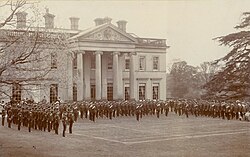Brogyntyn

Brogyntyn, or Porkington, is a mansion in the parish of Selatyn to the north-west of Oswestry in Shropshire, England. Brogyntyn Hall was the home of the Ormsby-Gore family from 1815, and had previously been the estate of their ancestors the Maurices and Owens since the sixteenth century. It was abandoned and uninhabited from around 1985.[1][2]
History[edit]


It was a residence of members of the princely dynasty of the Welsh Kingdom of Powys, belonging to the House of Mathrafal, and one of the taî'r uchelwyr (houses of the gentry) in late medieval Wales.[3] It subsequently came into the possession of the Ormsby-Gore family (Lord Harlech). Its English correspondent is sometimes given as Porkington.[4] A manuscript known to have been in the possession of Brogyntyn in 1574 was a copy of the Hanes Gruf(f)udd ab Cynan.
The house itself is of brick dating from circa 1730 refaced and much added to between 1813–20 by the architect Benjamin Gummow.[5] It is noted for a portico of four giant unfluted Ionic columns with scrolls and pediment. Outside can be seen an arch with 2 pairs of unfluted Ionic columns. In the entrance hall survives an elaborately carved fireplace dated 1617.
Brogyntyn Hall and its 1,445-acre estate, was sold by the 6th Baron Harlech in 2001 for less than £5 million to a local developer, who divided up the estate, and investigated the potential for a retirement community development in and around the Hall.[6][7] However, the Hall and 234 acres went up for sale for £5 million in December 2013.[8]
Brogyntyn Library[edit]

It is known that Sir Robert Owen of Brogyntyn (d. 1698) was a bibliophile who continued the family's traditional patronage of poets and a collection of printed English literature was developed by his grandfather Lewis Anwyl of Park. Nevertheless, the early history of the library at Brogyntyn is obscure. Some of the family had collected early printed books during the nineteenth century but this does not account for the fine collection of manuscripts that the library held.
There is some evidence contained within the manuscripts which suggests that the collection was formed circa 1700 from other manuscripts collections in the surrounding area.[1] The thirty Welsh language manuscripts that the third Lord Harlech deposited in the National Library of Wales in 1934 was, at the time, the largest collection of manuscripts in Welsh that was still privately owned.
The fourth Lord Harlech deposited a further fifty-nine manuscripts in the National Library in 1938 and subsequently donated most of the deposits in 1945. The remaining items were purchased from the sixth Lord Harlech, the incumbent in 1993.[2][9]
The manuscripts from the Brogyntyn Library include a medieval psalter and a version of Geoffrey of Monmouth's Historia Regum Britanniæ, both from the thirteenth century, a fifteenth century miscellany in Middle English, a volume of the Welsh laws of Hywel Dda, and pedigrees, genealogy and heraldry of families in Wales.[1][2][9]
See also[edit]
Notes[edit]
- ^ a b c "Brogyntyn Manuscripts". www.archiveswales.org.uk. Archived from the original on 4 March 2016. Retrieved 26 November 2015.
- ^ a b c Peters, Hilary (2006). Brogyntyn: Part 2 of Schedule. National Library of Wales.
- ^ Portrait Of Lewis Anwyl, 18th Century, Collection Of Lord Harlech Of Glyn Cywarch, Wales
- ^ "Brogyntyn, Oswestry". historicengland.org.uk.
- ^ Colvin H., A Biographical Dictionary of British Architects 1600–1840, Yale University Press, 3rd edition London, 1995, p 436, ISBN 9780300072075
- ^ The Daily Telegraph, "Fall of the house of Harlech" by Angela Pertusini and Hugh Davies, 22 Jun 2000
- ^ Gaunt Francis Architects proposals Archived December 27, 2013, at the Wayback Machine
- ^ Knight Frank reference CHO090108
- ^ a b Jones, E. D. (1939). "The Brogyntyn library". National Library of Wales Journal. 1 (1). Retrieved 26 November 2015.
References[edit]
- The Myvyrian Archaiology of Wales, Volume II Prose, London 1801, p. 605.
- N. Pevsner, Shropshire (The Buildings of England), Penguin 1958.
External links[edit]
- Brogyntyn Hall photos on ukurbex.co.uk
- Photos of Brogyntyn and surrounding area on geograph.org.uk
